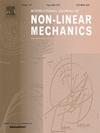Modeling of residual stiffness phenomenon in modified Iwan model of bolted joints and its application
IF 2.8
3区 工程技术
Q2 MECHANICS
International Journal of Non-Linear Mechanics
Pub Date : 2024-09-19
DOI:10.1016/j.ijnonlinmec.2024.104909
引用次数: 0
Abstract
Bolted joints have been widely used in various mechanical structures. Due to the presence of contact interfaces, the joints exhibit complex nonlinear behavior under dynamic loading. Effective prediction of the dynamic response of bolted structures requires the construction of appropriate dynamic models. This paper proposes a modified Iwan model which gives a more comprehensive description of joints than the previous Iwan models, especially for the phenomenon of residual stiffness in macro slip. The equations of the model's backbone curve, hysteresis curve, and energy dissipation are derived. The parameter identification procedure is also provided. Subsequently, connection elements based on the modified Iwan model are integrated into a single bolted joint and a thin-walled cylinder containing multiple bolted joints, the responses under quasi-static unidirectional loading, quasi-static cyclic loading and constant-frequency excitation are investigated. The physical interpretation of the parameters in the model is discussed, thus explaining the relationship between the bolted joint's physical parameters and some important variables. The results indicate that the model can effectively characterize the nonlinear mechanical behavior of the bolted joint for both micro and macro slip regime, with significant improvement in computational efficiency.
螺栓连接修正伊万模型中残余刚度现象的建模及其应用
螺栓连接已广泛应用于各种机械结构中。由于接触界面的存在,接头在动态载荷下表现出复杂的非线性行为。要有效预测螺栓连接结构的动态响应,需要构建适当的动态模型。本文提出了一种改进的 Iwan 模型,与之前的 Iwan 模型相比,该模型能更全面地描述接头,尤其是宏观滑移中的残余刚度现象。推导了模型的骨干曲线、滞后曲线和能量耗散方程。同时还提供了参数识别程序。随后,将基于改进 Iwan 模型的连接元件集成到单个螺栓连接和包含多个螺栓连接的薄壁圆柱体中,研究了准静态单向载荷、准静态循环载荷和恒频激励下的响应。讨论了模型参数的物理解释,从而解释了螺栓连接的物理参数与一些重要变量之间的关系。结果表明,该模型能有效描述螺栓连接在微滑移和大滑移情况下的非线性力学行为,并显著提高了计算效率。
本文章由计算机程序翻译,如有差异,请以英文原文为准。
求助全文
约1分钟内获得全文
求助全文
来源期刊
CiteScore
5.50
自引率
9.40%
发文量
192
审稿时长
67 days
期刊介绍:
The International Journal of Non-Linear Mechanics provides a specific medium for dissemination of high-quality research results in the various areas of theoretical, applied, and experimental mechanics of solids, fluids, structures, and systems where the phenomena are inherently non-linear.
The journal brings together original results in non-linear problems in elasticity, plasticity, dynamics, vibrations, wave-propagation, rheology, fluid-structure interaction systems, stability, biomechanics, micro- and nano-structures, materials, metamaterials, and in other diverse areas.
Papers may be analytical, computational or experimental in nature. Treatments of non-linear differential equations wherein solutions and properties of solutions are emphasized but physical aspects are not adequately relevant, will not be considered for possible publication. Both deterministic and stochastic approaches are fostered. Contributions pertaining to both established and emerging fields are encouraged.

 求助内容:
求助内容: 应助结果提醒方式:
应助结果提醒方式:


